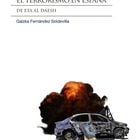The end point of ETA's performance as a terrorist organization, in October 2011, was followed by numerous publications relating to its history. In that cascade of new essays, the intense work of Gaizka Fernández Soldevilla from Baracaldés, belonging to the circle of studies on nationalism formed at the University of Leioa, soon stood out. The contribution of this nucleus came from behind, from the history of Basque Nationalist Action, by José Luis Granja, and with notable sector developments. He had already prepared a remarkable historical synthesis,
El
pendulo patriótico
, greeted with fervor by Xabier Arzalluz: "This is a book by historians and not by
elorzas
."
Fernández Soldevilla broke the fire in 2012, half with his colleague Raúl López Romo, in
ETA and radical nationalism
(1958-2011), offering a good synthesis of the double path, terrorist and political, followed by ETA throughout its history . The
Story of Euskadiko Ezkerra
followed in 2013
, and after it new works followed tirelessly, including
La will del gudari
(2016), a moment of reflection on the “genesis and reflection of ETA's violence [not terror]”. The series now closes with
Terrorism in Spain. From ETA to Daesh
, where the other terrorisms are still marginal with respect to the central Basque issue.
The author approaches this with a clear didactic sense, of a political chronicle on the one hand and on the other, as a complement, a selection of biographies of victims in which the mutations in ETA's own strategy are reflected. It is a subject already addressed previously by Rogelio Alonso and Florencio Domínguez in the masterful
Broken Lives
. At present, Soldevilla is a prominent figure in the recently officially inaugurated Memorial Center for the Victims of Terrorism, in which the historians of Leioa work. It is chaired by Florencio Domínguez. Given the current circumstances, both his works and the other published studies of the Center acquire a double dimension, historiographic and political.
The division arises between the approach, dominant in the Center, which sees in ETA an episodic phenomenon of the outbreak of terror, which had its beginning and has had its end, proof of “its error”, and the vision that frames ETA in a long history of nationalism;
with the ideology of hatred of the founder, Sabino Arana, inspiring both ETA and the calculated ambiguity of the PNV in the lead years.
It goes without saying that the official position of the Basque Government is willing to do everything possible to make the second option invisible.
The divide arises between the approach that sees in ETA an episodic phenomenon of terror and the vision that frames it in a long trajectory of nationalism, with the ambiguity of the PNV in the lead years
Fernández Soldevilla's work records a slippage from the first book with López Romo, where he reconstructed the black thread that starts from the ethnic exclusion of nationalism based on race with Sabino. In
The will of the gudari
changes and in
Terrorism in Spain
, the thesis of the Sabinian origin is openly refuted. Following Granja, he believes that the founder "always explicitly rejected violence." This is false and there are his first assaults on the Carlist Circle with the Spanish flag and the Bilbao center on Jardines street for admitting
maketos
. Another thing is that he was aware that the State was there. For Sabino, or for Arzalluz, the Jesuit imprint is always forgotten, without which little is understood.
The effects of this option are clear. In addition to the distance in the procedures, there would be no common history in the difference between democratic and terrorist nationalism, something unsustainable. This affects the validity of Fernández Soldevilla's account in one of the most significant flashes, the murder of Baglietto in Azkoitia, with the ETA members openly supported by local nationalism (detail omitted, as in the
recently published
book of
History and Memory
) . It is already a habitual misuse: let's think about the documentary
Lagun and the resistance against ETA
, exhaustive when reviewing the destruction of the library by the filoetarras, forgetful of the brutal nationalist attack, from Arzalluz to Ardanza, against those who demanded the protection of the Basque Government.
It would have been great if that were the case, but the image of ETA as a nightmare that arises at one point and dissipates between 2011 and 2018 does not correspond to reality.
The Memory Center, and Gaizka Fernández Soldevilla in it, are carrying out a splendid anatomical work on ETA, which reaches the recent first volume of the
History and memory of terrorism in the Basque Country
, coordinated by José Antonio Pérez, with valuable collaborators .
But it does not make historiographical sense to establish a limited vision that prevents us from understanding how the nationalist Basque society generated ETA and to a large extent accompanied it.
Vox reminds us that badly buried political corpses end up turning into the living dead.
'Terrorism in Spain: from ETA to Daesh'
Gaizka Fernández Soldevilla Cátedra, 2021. 434 pages.
18 euros
Look for it in your bookstore
You can follow BABELIA on
and
, or sign up here to receive
our weekly newsletter
.

